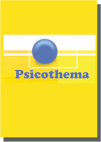Abstract
Relationship among self-efficacy, rigidity and derivation of functions through stimulus equivalence is addressed. Eight subjects who scored high on a self-efficacy scale were selected, four of them scoring high on a rigidity questionnaire and four scoring low. They were trained to form two equivalence classes (Class~1: A1, B1, C1, D1; Class~2: A2, B2, C2, D2). Then, specific self-efficacy verbalizations about unperformed tasks (A1 and A2) were assessed and only subjects presenting high levels of selfefficacy continued. Then, subjects had to perform two tasks from Class~1 (A1 and B1). Both tasks were manipulated so that subjects received false feedback indicating unsuccessful performance. Lastly, subjects were tested for their specific self-efficacy verbalizations about unperformed tasks (C1, D1, A2, B2, C2 and D2). Results showed that high rigidity scorers maintained original high self-efficacy verbalizations and that low scorers changed original self-efficacy verbalizations, reporting not to have abilities enough to solve the novel tasks.Downloads
Download data is not yet available.
